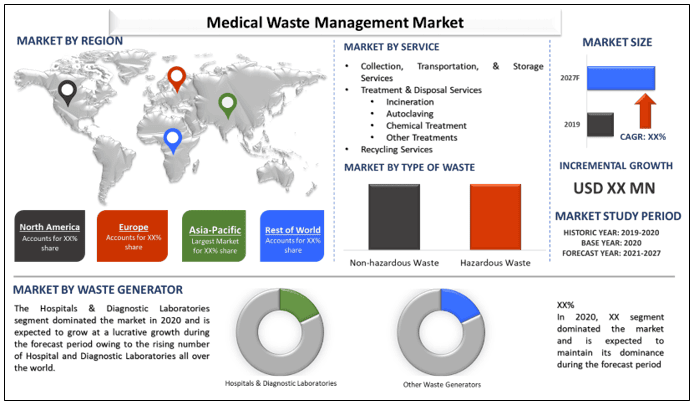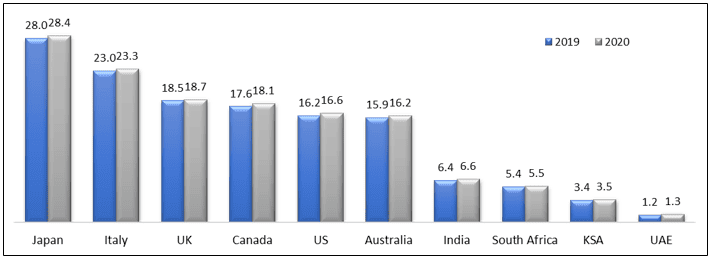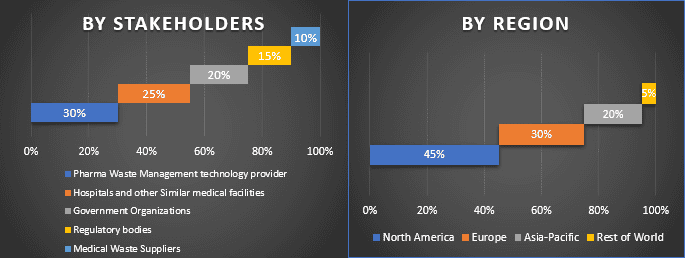- Home
- Chi siamo
- Settore
- Servizi
- Lettura
- Contattaci
Mercato della Gestione dei Rifiuti Sanitari: Analisi Attuale e Previsioni (2021-2027)
Importanza del Servizio (Servizi di Raccolta, Trasporto e Stoccaggio, Servizi di Trattamento e Smaltimento e Servizi di Riciclaggio); Tipo di Rifiuto (Rifiuti Non Pericolosi e Rifiuti Pericolosi); Sito di Trattamento (Trattamento Offsite e Trattamento Onsite); Produttore di Rifiuti (Ospedali e Laboratori Diagnostici e Altri Produttori di Rifiuti); Regione e Paese

Il mercato della gestione dei rifiuti sanitari è stato valutato a 6,6 miliardi di dollari nel 2020 e si prevede che raggiungerà i 9,4 miliardi di dollari entro il 2027, mostrando un CAGR elevato del 5,26% nel periodo di previsione (2021-2027). I rifiuti sanitari sono i rifiuti prodotti da strutture sanitarie come studi medici, ospedali, studi dentistici, laboratori, strutture di ricerca medica e cliniche veterinarie che contengono materiale infettivo. I rifiuti sanitari possono includere fluidi corporei come siero, sangue o altri contaminanti. Secondo il Medical Waste Tracking Act (1988), i rifiuti sanitari sono rifiuti generati durante la ricerca medica, i test, la diagnosi, l'immunizzazione o il trattamento di esseri umani o animali. Alcuni esempi sono vetreria, piastre di coltura, bende, guanti, oggetti taglienti scartati come aghi o bisturi, tamponi e tessuti. La domanda di gestione dei rifiuti sanitari è in aumento a causa della crescente popolazione anziana, che a sua volta sta aumentando il numero di pazienti affetti da malattie croniche o infettive, portando a un aumento del volume dei rifiuti sanitari. Di conseguenza, con l'aumento del volume dei rifiuti sanitari, le organizzazioni governative di tutto il mondo stanno prendendo varie iniziative per la gestione dei rifiuti sanitari. Inoltre, la crescente consapevolezza in merito alla gestione dei rifiuti sanitari sta guidando anche la crescita del mercato.
Popolazione di età pari o superiore a 65 anni (% della popolazione totale)

Approfondimenti presentati nel report
“Tra i servizi, il segmento dei servizi di raccolta, trasporto e stoccaggio detiene la quota maggiore.”
In base al servizio, il mercato è frammentato in servizi di raccolta, trasporto e stoccaggio, servizi di trattamento e smaltimento e servizi di riciclaggio. Si prevede che il segmento dei servizi di raccolta, trasporto e stoccaggio crescerà a un ritmo redditizio durante il periodo previsto a causa della presenza di normative rigorose per la raccolta, il trasporto e lo stoccaggio dei rifiuti sanitari. Inoltre, fattori quali l'aumento del volume dei rifiuti sanitari e lo sviluppo di laboratori di ricerca o ospedali promuovono anche la crescita del segmento.
“Tra i tipi di rifiuti, il segmento dei rifiuti non pericolosi detiene la quota maggiore.”
In base al tipo di rifiuto, il mercato è suddiviso in rifiuti non pericolosi e rifiuti pericolosi. Il segmento dei rifiuti non pericolosi ha dominato il mercato nel 2020 e si prevede che crescerà a un ritmo redditizio durante il periodo previsto a causa dell'aumento del numero di cliniche e ospedali e dell'aumento della domanda di prodotti sanitari per il trattamento delle malattie. Secondo l'OMS, della quantità totale di rifiuti generati dalle attività sanitarie, circa l'85% è costituito da rifiuti generici non pericolosi.
“Tra i siti di trattamento, si prevede che il segmento offsite crescerà al CAGR più elevato durante il periodo analizzato.”
In base al sito di trattamento, il mercato è suddiviso in trattamento offsite e trattamento onsite. Il segmento offsite ha dominato il mercato nel 2020 e si prevede che crescerà a un ritmo redditizio durante il periodo previsto a causa della crescente prevalenza di malattie croniche, degli elevati progressi nel settore della ricerca e sviluppo in ambito sanitario e dell'uso di tecnologie innovative nella gestione dei rifiuti. La crescente base di popolazione geriatrica con una maggiore predisposizione a varie malattie legate all'età come cancro, malattie cardiovascolari, artrite, ipertensione, ecc. è una delle principali cause che sta accelerando la crescita del mercato della gestione dei rifiuti.
“Tra i produttori di rifiuti, si prevede che il segmento degli ospedali e dei laboratori di diagnostica crescerà al CAGR più elevato durante il periodo analizzato.”
In base al produttore di rifiuti, il mercato è frammentato in ospedali e laboratori di diagnostica e altri produttori di rifiuti. Il segmento degli ospedali e dei laboratori di diagnostica ha dominato il mercato nel 2020 e si prevede che crescerà a un ritmo redditizio durante il periodo di previsione a causa del crescente numero di ospedali e laboratori di diagnostica in tutto il mondo e dell'aumento della produzione di rifiuti sanitari. Secondo l'OMS, i paesi ad alto reddito generano in media fino a 0,5 kg di rifiuti pericolosi per letto ospedaliero al giorno, mentre i paesi a basso reddito generano in media 0,2 kg.
“La regione del Nord America rappresenta uno dei mercati più grandi e si prevede che sarà uno dei mercati in più rapida crescita del mercato della gestione dei rifiuti sanitari.”
Per una migliore comprensione dell'adozione del mercato della gestione dei rifiuti sanitari, il mercato viene analizzato in base alla sua presenza mondiale nei paesi come Nord America (Stati Uniti, Canada e resto del Nord America), Europa (Germania, Francia, Spagna, Regno Unito e resto d'Europa), Asia-Pacifico (Cina, Giappone, India, Australia e resto dell'APAC) e resto del mondo. Il Nord America dominerà il mercato della gestione dei rifiuti sanitari a causa della crescente popolazione anziana e delle rigide normative in questa regione. Inoltre, la crescente incidenza di malattie croniche, la presenza di attori chiave, l'aumento della consapevolezza ambientale in merito alla gestione dei rifiuti e l'aumento del volume dei rifiuti sanitari nella regione promuovono anche la crescita del mercato. Alcuni dei principali operatori che operano sul mercato includono Stericycle, Veolia Environnement S.A., Suez Environnement, Clean Harbors, REMONDIS AG & Co. KG, Sharps Compliance, Inc., Waste Management, Inc., BioMedical Waste Solutions, LLC, Daniels Sharpsmart Inc., Republic Services, Inc. Diverse operazioni di fusione e acquisizione insieme a partnership sono state intraprese da questi operatori per aumentare la loro presenza in diverse regioni.
Motivi per acquistare questo report:
- Lo studio include l'analisi delle dimensioni e delle previsioni del mercato convalidate da esperti chiave del settore autenticati
- Il report presenta una rapida panoramica delle prestazioni complessive del settore a colpo d'occhio
- Il report copre un'analisi approfondita dei principali concorrenti del settore con un focus primario sui principali dati finanziari aziendali, sul portafoglio prodotti, sulle strategie di espansione e sugli sviluppi recenti
- Esame dettagliato dei driver, dei vincoli, delle tendenze chiave e delle opportunità prevalenti nel settore
- Lo studio copre in modo completo il mercato attraverso diversi segmenti
- Analisi approfondita a livello regionale del settore
Opzioni di personalizzazione:
Il mercato della gestione dei rifiuti sanitari può essere ulteriormente personalizzato in base alle esigenze o a qualsiasi altro segmento di mercato. Inoltre, UMI comprende che potresti avere le tue esigenze aziendali, quindi sentiti libero di metterti in contatto con noi per ottenere un report che si adatti completamente alle tue esigenze.
Indice
L'analisi del mercato storico, la stima del mercato attuale e la previsione del mercato futuro del Global Medical Waste Management sono stati i tre passaggi principali intrapresi per creare e analizzare la domanda di Medical Waste Management per i diversi servizi come i servizi di raccolta, trasporto e stoccaggio, i servizi di trattamento e smaltimento e i servizi di riciclaggio. È stata condotta un'esauriente ricerca secondaria per raccogliere i dati storici del mercato e stimare le dimensioni del mercato attuale. In secondo luogo, per convalidare queste intuizioni, sono state prese in considerazione numerose scoperte e ipotesi. Inoltre, sono state condotte anche esaurienti interviste primarie con esperti del settore lungo tutta la catena del valore del settore Medical Waste Management. Dopo l'assunzione e la convalida dei dati di mercato attraverso interviste primarie, abbiamo impiegato un approccio top-down per prevedere le dimensioni complete del mercato. Successivamente, sono stati adottati metodi di ripartizione del mercato e di triangolazione dei dati per stimare e analizzare le dimensioni del mercato dei segmenti e dei sottosegmenti a cui appartiene il settore. La metodologia dettagliata è spiegata di seguito:
Analisi delle dimensioni storiche del mercato
Fase 1: studio approfondito delle fonti secondarie:
È stato condotto uno studio secondario dettagliato per ottenere le dimensioni storiche del mercato del Medical Waste Management attraverso fonti interne all'azienda come relazioni annuali e bilanci, presentazioni sulle prestazioni, comunicati stampa, ecc. e fonti esterne tra cui riviste, notizie e articoli, pubblicazioni governative, pubblicazioni della concorrenza, relazioni di settore, database di terze parti e altre pubblicazioni credibili.
Fase 2: segmentazione del mercato:
Dopo aver ottenuto le dimensioni storiche del mercato del Medical Waste Management, abbiamo condotto un'analisi secondaria dettagliata per raccogliere informazioni storiche sul mercato e condividere per diversi segmenti. I principali segmenti inclusi nel rapporto sono Servizio, Tipo di rifiuto, Sito di trattamento, Produttore di rifiuti e regione/paese. Sono state condotte ulteriori analisi a livello di paese per valutare l'adozione complessiva del Medical Waste Management in ogni regione.
Fase 3: analisi dei fattori:
Dopo aver acquisito le dimensioni storiche del mercato di diversi segmenti e sottosegmenti, abbiamo condotto una dettagliata analisi dei fattori per stimare le dimensioni attuali del mercato del Medical Waste Management. Inoltre, abbiamo condotto un'analisi dei fattori utilizzando variabili dipendenti e indipendenti come l'elevata prevalenza di malattie cardiovascolari e casi di cancro e la popolazione anziana in rapida crescita.
Stima e previsione delle dimensioni attuali del mercato
Dimensionamento attuale del mercato: sulla base di informazioni utili derivanti dalle 3 fasi precedenti, siamo giunti alle dimensioni attuali del mercato, ai principali attori del mercato del Medical Waste Management e alle quote di mercato dei segmenti. Tutte le quote percentuali richieste e le ripartizioni del mercato sono state determinate utilizzando l'approccio secondario sopra menzionato e sono state verificate attraverso interviste primarie.
Stima e previsione: per la stima e la previsione del mercato, sono stati assegnati pesi diversi a vari fattori, tra cui driver e tendenze, vincoli e opportunità disponibili per le parti interessate. Dopo aver analizzato questi fattori, sono state applicate tecniche di previsione pertinenti, ovvero l'approccio top-down, per arrivare alla previsione di mercato per il 2027 per diversi segmenti e sottosegmenti nei principali mercati a livello globale. La metodologia di ricerca adottata per stimare le dimensioni del mercato comprende:
- Le dimensioni del mercato del settore, in termini di valore (USD) e il tasso di adozione del Medical Waste Management nei principali mercati a livello nazionale
- Tutte le quote percentuali, le ripartizioni e le suddivisioni dei segmenti e sottosegmenti di mercato
- I principali attori del mercato del Medical Waste Management in termini di servizi offerti. Inoltre, le strategie di crescita adottate da questi attori per competere nel mercato in rapida crescita.
Convalida delle dimensioni e della quota di mercato
Ricerca primaria: sono state condotte interviste approfondite con i Key Opinion Leaders (KOL), compresi i Top Level Executives (CXO/VP, Sales Head, Marketing Head, Operational Head e Regional Head, Country Head, ecc.) nelle principali regioni. I risultati della ricerca primaria sono stati quindi riassunti ed è stata eseguita un'analisi statistica per dimostrare l'ipotesi dichiarata. I contributi della ricerca primaria sono stati consolidati con i risultati secondari, trasformando così le informazioni in informazioni fruibili.
Ripartizione dei partecipanti primari nelle diverse regioni

Ingegneria del mercato
È stata impiegata la tecnica di triangolazione dei dati per completare la stima complessiva del mercato e per ottenere numeri statistici precisi di ciascun segmento e sottosegmento del mercato del Medical Waste Management. I dati sono stati suddivisi in diversi segmenti e sottosegmenti dopo aver studiato vari parametri e tendenze nelle aree di servizio, tipo di rifiuto, sito di trattamento, produttori di rifiuti e regione del mercato del Medical Waste Management.
Obiettivo principale dello studio sul mercato del Medical Waste Management
Le tendenze attuali e future del mercato del Medical Waste Management sono individuate nello studio. Gli investitori possono ottenere informazioni strategiche per basare la loro discrezione per gli investimenti dall'analisi qualitativa e quantitativa eseguita nello studio. Le tendenze di mercato attuali e future determinerebbero l'attrattiva complessiva del mercato a livello regionale, fornendo una piattaforma per il partecipante industriale per sfruttare il mercato non sfruttato a vantaggio di un vantaggio di first-mover. Altri obiettivi quantitativi degli studi includono:
- Analizzare le dimensioni attuali e previste del mercato del Medical Waste Management in termini di valore (USD). Inoltre, analizzare le dimensioni attuali e previste del mercato di diversi segmenti e sottosegmenti del settore
- I segmenti nello studio includono Servizio, Tipo di rifiuto, Sito di trattamento, Produttore di rifiuti e regione/paese
- Analizzare la catena del valore coinvolta con la presenza di vari intermediari, insieme all'analisi dei comportamenti dei clienti e della concorrenza relativi al settore
- Definire e analizzare le normative governative per il mercato del Medical Waste Management a livello globale
- Analizzare le dimensioni attuali e previste del mercato in tutto il mondo. Le principali regioni analizzate nel rapporto includono Nord America (Stati Uniti, Canada, Resto del Nord America), Europa (Germania, Regno Unito, Francia, Spagna, Resto d'Europa), Asia-Pacifico (Cina, Giappone, India, Australia, Resto dell'Asia-Pacifico) e Resto del mondo
- Definire e analizzare il panorama competitivo del settore del mercato del Medical Waste Management e le strategie di crescita adottate dagli operatori di mercato per sostenersi nel mercato in rapida crescita
- Analisi approfondita a livello regionale del settore
Correlati Report
I clienti che hanno acquistato questo articolo hanno acquistato anche










